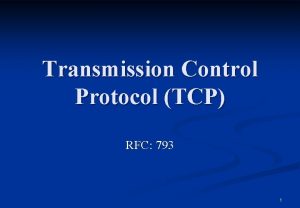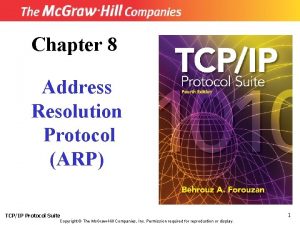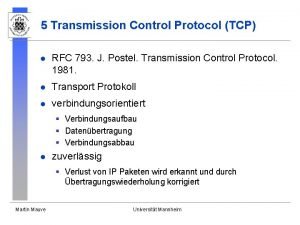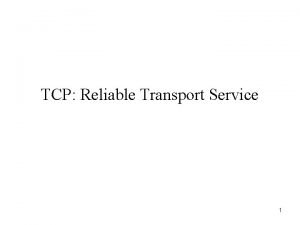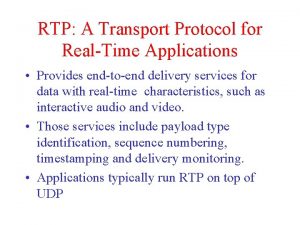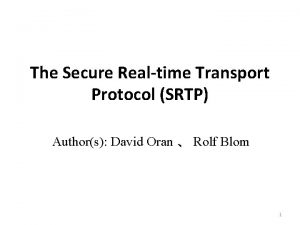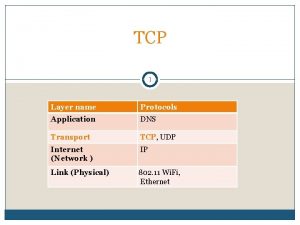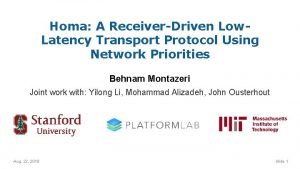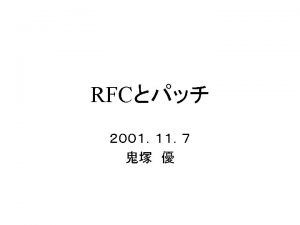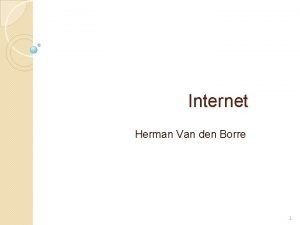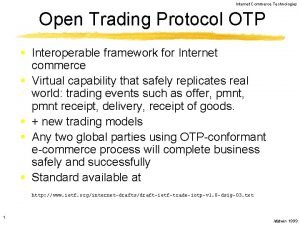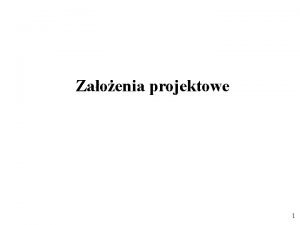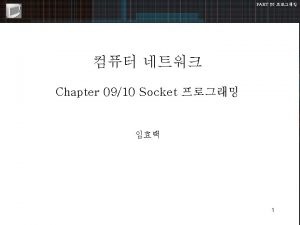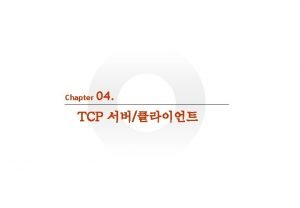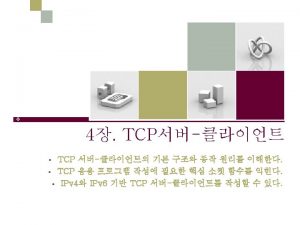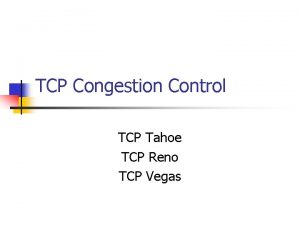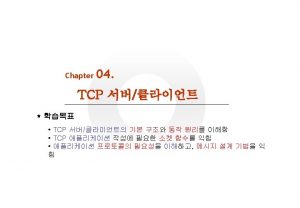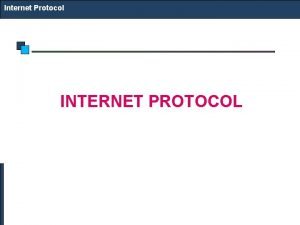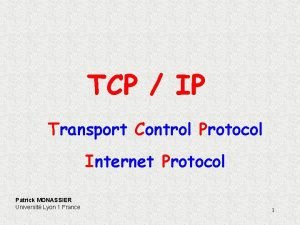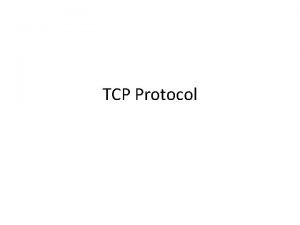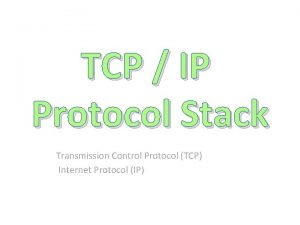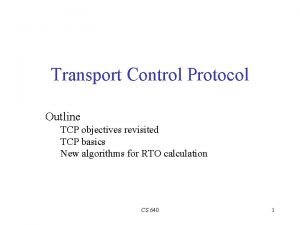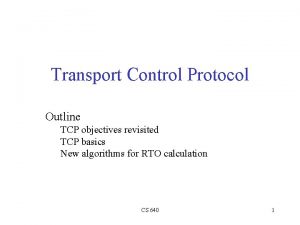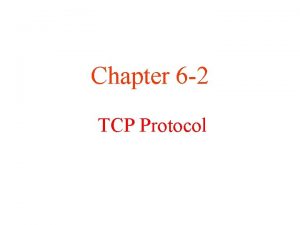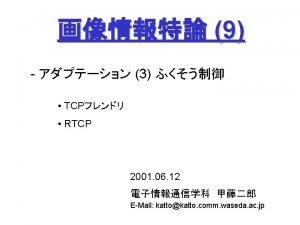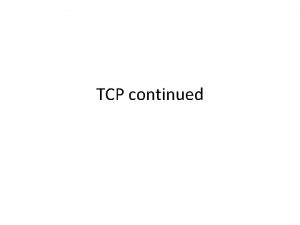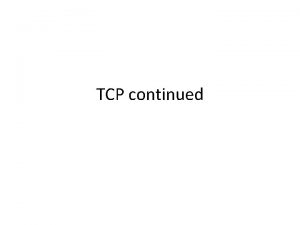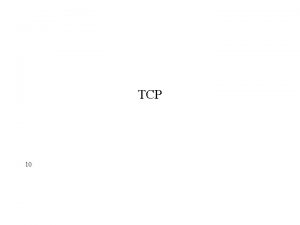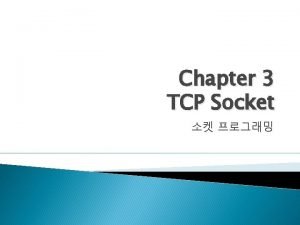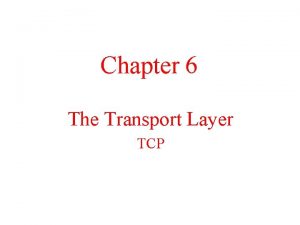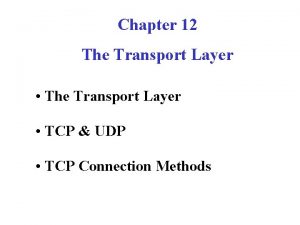Chapter 6 2 TCP Protocol The Internet Transport








































- Slides: 40

Chapter 6 -2 TCP Protocol

The Internet Transport Protocols: TCP • • • Introduction to TCP The TCP Service Model The TCP Protocol The TCP Segment Header TCP Connection Management TCP Flow Control TCP Congestion Control TCP Timer Management Wireless TCP and UDP

TCP/IP protocol suite

TCP: Overview a) point-to-point: – one sender, one receiver b) reliable, in-order byte stream: – no “message boundaries” c) continuous ARQ: – TCP congestion and flow control set window size d) send & receive buffers RFCs: 793, 1122, 1323, 2018, 2581 a) full duplex data: – bi-directional data flow in same connection – MSS: maximum segment size b) connection-oriented: – handshaking (exchange of control msgs) init’s sender, receiver state before data exchange c) flow controlled: – sender will not overwhelm receiver

TCP SERVICES Connection-Oriented Service Process-to-Process Communication Stream Delivery Service Full-Duplex Communication Reliable Service

Well-Known Ports for TCP Port 21 23 25 69 79 80 119 Protocol FTP Telnet SMTP TFTP Finger HTTP POP-3 NNTP Use File transfer Remote login E-mail Trivial File Transfer Protocol Lookup info about a user World Wide Web Remote e-mail access USENET news

Stream delivery

Sending and receiving buffers

TCP segments

Message Boundary (a) Four 512 -byte segments sent as separate IP datagrams. (b) The 2048 bytes of data delivered to the application in a single READ CALL.

The TCP Segment Header TCP Header.

Control field

TCP Checksum The pseudoheader included in the TCP checksum.

TCP seq. #’s and ACKs Seq. #’s: 1. byte stream “number” of first byte in segment’s data ACKs: 1. seq # of next byte expected from other side 2. cumulative ACK Q: how receiver handles out-oforder segments – A: TCP spec doesn’t say, - up to implementor Host B Host A User types ‘C’ Seq=4 2, ACK = 79, da ta ata = d , 3 4 K= , AC q=79 Se host ACKs receipt of echoed ‘C’ = ‘C’ host ACKs receipt of ‘C’, echoes back ‘C’ Seq=4 3, ACK =80 simple telnet scenario time

TCP Connection Establishment 6 -31 (a) TCP connection establishment in the normal case: 3 -way Handshake (b) Call collision.

TCP Connection Management Modeling The states used in the TCP connection management finite state machine.

TCP Connection Management Modeling (2) TCP connection management finite state machine. The heavy solid line is the normal path for a client. The heavy dashed line is the normal path for a server. The light lines are unusual events. Each transition is labeled by the event causing it and the action resulting from it, separated by a slash.

Connection termination using three-way handshaking

Half-close

Common scenario

TCP Flow Control Window management in TCP: Credit Mechanism

Sliding window

Silly Window Syndrome

TCP Congestion Control (a) A fast network feeding a low capacity receiver. (b) A slow network feeding a high-capacity receiver.

Router queues

Slow start, exponential increase

Congestion avoidance, additive increase

Fast retransmission

TCP congestion policy summary

Congestion example

TCP timers

RTT: Retransmission Timer (a) Probability density of ACK arrival times in the data link layer. (b) Probability density of ACK arrival times for TCP.

TCP Round Trip Time and Timeout Estimated. RTT = (1 - )*Estimated. RTT + *Sample. RTT a) Exponential weighted moving average b) influence of past sample decreases exponentially fast c) typical value: = 0. 125

Example RTT estimation:

TCP Round Trip Time and Timeout Setting the timeout a) Estimted. RTT plus “safety margin” – large variation in Estimated. RTT -> larger safety margin b) first estimate of how much Sample. RTT deviates from Estimated. RTT: Dev. RTT = (1 - )*Dev. RTT + *|Sample. RTT-Estimated. RTT| (typically, = 0. 25) Then set timeout interval: Timeout. Interval = Estimated. RTT + 4*Dev. RTT

Options

SACK

SACK Example

TCP package

Wireless TCP and UDP Splitting a TCP connection into two connections.
 Internet transport protocol in computer networks
Internet transport protocol in computer networks Rfc tcp protocol
Rfc tcp protocol Arp protocol in tcp/ip
Arp protocol in tcp/ip Nagle algorithmus deaktivieren
Nagle algorithmus deaktivieren Tcp (transmission control protocol) to protokół
Tcp (transmission control protocol) to protokół To achieve reliable transport in tcp
To achieve reliable transport in tcp Tcp connection management finite state machine
Tcp connection management finite state machine A transport protocol for real time applications
A transport protocol for real time applications Secure real time transport protocol
Secure real time transport protocol Dns transport layer protocol
Dns transport layer protocol Design goals of transport layer protocol
Design goals of transport layer protocol Homa
Homa Uniport symport antiport
Uniport symport antiport Primary vs secondary active transport
Primary vs secondary active transport Now answer the questions
Now answer the questions Passive transport vs active transport venn diagram
Passive transport vs active transport venn diagram Pinocytosis vs phagocytosis
Pinocytosis vs phagocytosis Primary active transport vs secondary active transport
Primary active transport vs secondary active transport Bioflix activity membrane transport active transport
Bioflix activity membrane transport active transport What is passive transport
What is passive transport Bioflix activity membrane transport active transport
Bioflix activity membrane transport active transport Security architecture for the internet protocol
Security architecture for the internet protocol Internet protocol stack 5 layers
Internet protocol stack 5 layers Internet official protocol standards
Internet official protocol standards Internet protocol cursus
Internet protocol cursus Iotp
Iotp Schemat logiczny sieci komputerowej
Schemat logiczny sieci komputerowej Iptv internet protocol television
Iptv internet protocol television Adaptive internet protocol
Adaptive internet protocol What is internet
What is internet Hình ảnh bộ gõ cơ thể búng tay
Hình ảnh bộ gõ cơ thể búng tay Bổ thể
Bổ thể Tỉ lệ cơ thể trẻ em
Tỉ lệ cơ thể trẻ em Gấu đi như thế nào
Gấu đi như thế nào Thang điểm glasgow
Thang điểm glasgow Chúa sống lại
Chúa sống lại Môn thể thao bắt đầu bằng từ đua
Môn thể thao bắt đầu bằng từ đua Thế nào là hệ số cao nhất
Thế nào là hệ số cao nhất Các châu lục và đại dương trên thế giới
Các châu lục và đại dương trên thế giới Cong thức tính động năng
Cong thức tính động năng

